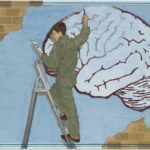The Brain of the Hoarder: Why the Disorder Affects Certain People
It can be difficult to understand why some people become hoarders. Shouldn’t it be easy for them to throw away old items that other people view as trash? This might seem like a reasonable question, but there is now plenty of research available that can help explain why some people become afflicted with this confusing disorder.
Some of the most technical research involves the activity that takes place in the brain of a hoarder when he or she is tasked with throwing something away. Although some results of hoarding are like those of obsessive-compulsive disorder, the brain patterns involved are significantly different. While some people may suffer from both conditions, they seem to be caused by brain activities that are markedly unalike. In fact, only about 18% of people who show symptoms of hoarding also meet the criteria of having OCD.
The two disorders seem to exist on a spectrum that includes several related conditions, according to Dr. Eric Hollander of The Albert Einstein School of Medicine, who serves as the director of the autism and OCD spectrum disorder program. His research shows that there is substantial evidence that hoarding should be recognized as a distinct disorder from OCD. This doesn’t mean that diagnosis and treatment might not be similar, but it does show that there is not a strong correlation between the two disorders.
A study at the Institute of Living in Hartford, Connecticut conducted fMRIs (functional magnetic resonance imaging) on 107 different people. The study, conducted by David Tolin, included 33 control models who had no disorders, 31 with OCD, and 43 who suffered from hoarding.

Part 2 of Brain of a Hoarder
Each person was required to bring some junk mail or old papers under the promise that the materials would be returned to them at the end of the study. They were informed that they would need to make a decision to either destroy these items or keep them intact – during their responses their brain waves would be imaged. Testers would show the participants a slide that either said “yours” or “ours” and would follow up with a picture of junk mail or newspaper. From here, they would choose to shred the item or keep it.
The results of the study showed significant variation in the responses of those with hoarding disorder when compared to both the control group and the group of participants who had OCD. Most hoarders chose to keep more of their own items than either of those groups. That, however, was not the purpose of the study, as researchers fully expected that result.
Where the study gets interesting is in the brain activity registered by the hoarders in comparison with the other groups. When asked about throwing away their own items, the decision-making part of the brain – known as the anterior cingulate cortex – showed far more activity in hoarders than it did in non-hoarders. This region of the brain is often the most active when facing uncertainty or confusing information.
Another part of the brain known as the insula showed increased usage as well. The insula is responsible for regulating emotional and physical well-being and is often responsible for negative emotions such as fear, embarrassment, or resentment. The combination of the insula and anterior cingulate cortex work together to make a person perceive how important an object might be.
These results seem to show that hoarders find it particularly challenging to grasp the true value of their own possessions. The regions of the brain that become most active when approached with conflict or uncertainty were far more active for the hoarders, suggesting that they experience strong negative emotions in any event that requires them to get rid of their items. Essentially, hoarders place elevated value on any of their possessions, so they find it far more difficult to throw them out.
In addition to the negative emotions associated with the questions they were asked; hoarders took a much longer time to decide whether to throw out their items. Brain imaging showed that portions associated with grief and anxiety were also more active. It seems that hoarders are very uncomfortable when they feel as though they are giving up something that could be useful in the future. If they are forced or pushed to give up these objects, they might lash out in anger or hysteria.
Part 3 Brain of a Hoarder
Another noteworthy finding comes from when the hoarders were asked to decide whether to shred junk mail that didn’t belong to them. In this case, their anterior cingulate cortex and insula showed lower activity than those of the other two groups. Researchers noticed a similarity in this reduced brain activity as they have seen in autism patients.
This is interesting because autistic people tend to exhibit obsessive behavior and experience discomfort when asked to go against their daily routines. They also often lack normal levels of engagement with other people. Researchers pointed out that this lowered activity in the brain could contribute to a lack of motivation and awareness. This would explain why so many hoarders aren’t bothered by living in such confined quarters surrounded by clutter and trash.
On the other hand, the increased activity when faced with throwing away their own items could indicate that they experience excessive anxiety about their belongings and find it particularly overwhelming when tasked with getting rid of them. Basically, their thoughts are so negative and intense when confronted with throwing something away that they can’t help but focus on it. Someone without the disorder would likely disregard the item, but a hoarder can’t take it off his or her mind. The result is that they are unable to perform their everyday functions as these anxieties continue to affect them.
These studies show that hoarders are not just lazy slobs or collectors with obsessive-compulsive disorder. Rather, their brains make it nearly impossible for them to get rid of their possessions. They assign a higher value level to anything that they own than is reasonable. This seems silly to a non-hoarder, but as observed in the control group, brain patterns are very different when given the option to throw something away or to keep it.
There is still much research to be done to identify the root causes of hoarding, but these studies have shed some light on why hoarders act the way that they do. They explain how brain chemistry and activity can play a large part in their reactions and emotions when they are asked to throw something out. A non-hoarder can’t comprehend this because they don’t experience the same electric signals or activation as a hoarder.

Part 4 Brain of a Hoarder
More studies will certainly be done to gather more information and find stronger correlations between hoarding and brain chemistry, but these results are encouraging, both for research and for treatment. Those who authored the study suggest that TMS, or transcranial magnetic stimulation, could be an option for treating the disorder. It is currently used to help treat depression by stimulating the brain with electrical currents.
If the technology is developed even further, doctors may be able to provide stimulation for the insula and the anterior cingulate cortex. Newer models of the transcranial magnetic stimulation machines can reach deeper into the brain thanks to an improved coiled shape that penetrates further. The insula is a pretty deep portion of the brain, so this could be a step in the right direction for treating the hoarding disorder.
Just as important as treating the disorder, however, may be teaching friends and family members to understand the reason for it and to end stigmatization. These studies go a long way in doing so, as they show that the hoarders exhibit certain brain patterns that may be out of their control, ending the idea that their hoarding is some conscious behavior or that they are just being unreasonable.
Part 5 Brain of a Hoarder
Emotions play a strong role in how people act, and when one cannot control strong negative emotions, it can be very difficult to cope with. The hoarding response to external factors may be strongly tied with overactive or underactive regions of the brain and not with poor personal hygiene or laziness. Studies such as these help people to understand the reasons for these disorders and are the basis for finding safe, effective treatment that goes after the cause rather than only the symptoms. As researchers continue to give their efforts in these studies, it seems that there are positive signs for the treatment of the hoarding disorder.
Acknowledging hoarding as a disorder is the first step in making treatment possible. We now know that a hoarder’s brain is affected far differently than the brain of a person without the condition, and this will go a long way in helping hoarders to address their symptoms and live a functional life. Hoarding can alienate patients from their loved ones and from society, but with proper treatment and therapy, they can learn to manage their condition. Thanks to research and advances in medical science, hoarding does not need to be the debilitating disorder that it once was.









